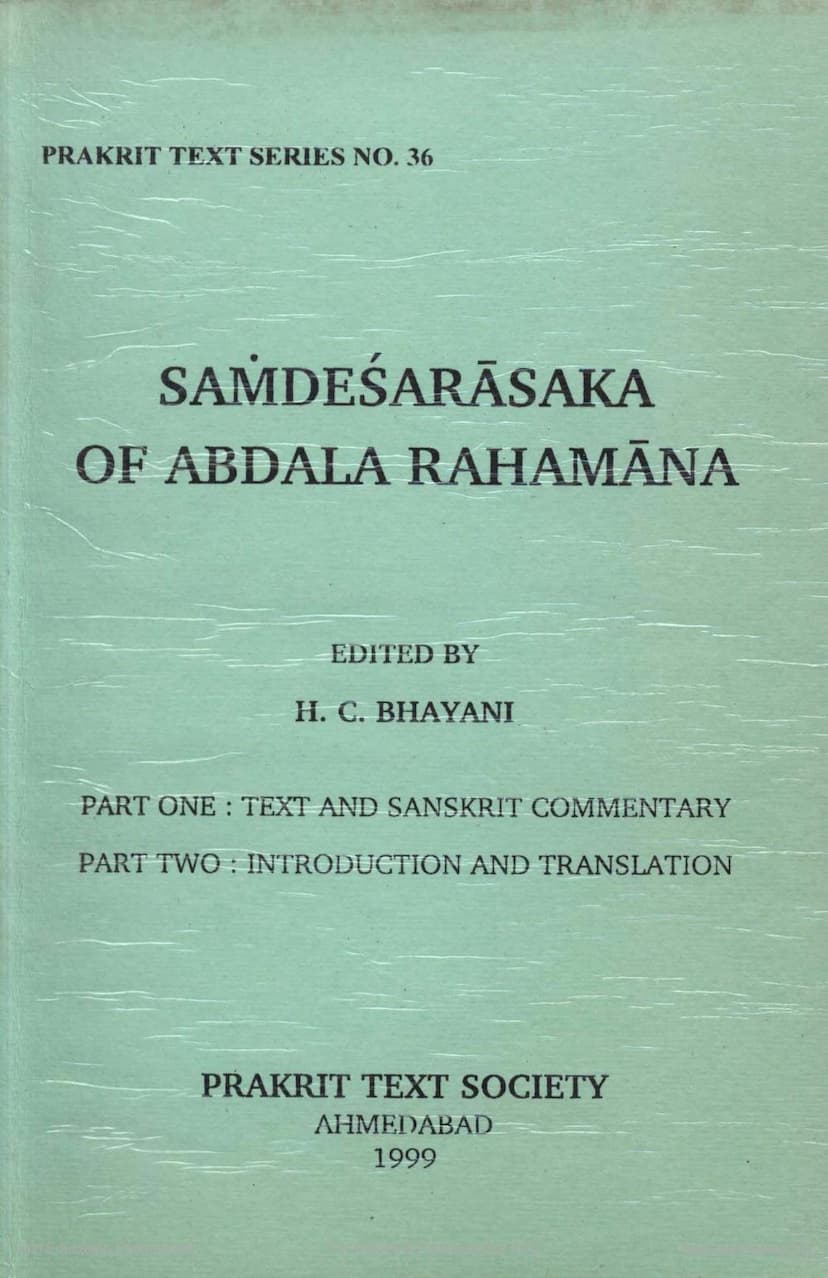Samdesarasaka Of Abdala Rahamana
Added to library: September 2, 2025

Summary
Here's a comprehensive summary of the Jain text "Samdesarasaka of Abdala Rahamana" based on the provided information:
Title: Samdesarasaka of Abdala Rahamana Author: Abdul Rahman (Abdala Rahamana) Publisher: Prakrit Text Society, Ahmedabad Year of Publication (Edition Provided): 1999 Series: Prakrit Text Series No. 36 Language: Apabhramsa
Overview:
The "Samdesarasaka" (meaning "Message-Rasa" or "Poem of Messages") is a significant Apabhramsa poem composed by Abdul Rahman, believed to be a Muslim poet who wrote in the Apabhramsa tradition. This text is a message poem, likely conveying a love message from a woman separated from her beloved. The edition provided is a scholarly work with extensive introductions, the Apabhramsa text, a Sanskrit commentary, and translations. It is highly regarded for its literary merit, linguistic insights into Apabhramsa, and its depiction of seasonal descriptions.
Key Aspects and Content:
-
Author and Context: Abdul Rahman was a weaver from the Mleccha country (likely in present-day Pakistan/Sindh region) who was renowned for his Prakrit poems and musical compositions. He is presented as a poet who followed in the tradition of excellent poets, proficient in grammar and prosody, and capable of composing in multiple languages including Apabhramsa, Sanskrit, Prakrit, and Paisacika. The poem reflects a cultural milieu where Apabhramsa was a significant literary language.
-
Literary Form and Structure: The "Samdesarasaka" is identified as a "Sandesa" (message) type of composition. It is a significant example of Apabhramsa poetry, particularly noted for its poetic form and structure. The poem is divided into three sections, or "Prakramas," which delineate the progression of the narrative and the seasonal descriptions (Bārahamāsā). The structure involves various metres, with "Rasa" (a type of strophic metre) and "Doha" being prominent. The scholarly introduction delves deeply into the metrical analysis of these sections.
-
Theme and Narrative: The poem tells the story of a separated woman, likely from Vijayanagara, who is deeply suffering from the pangs of separation from her beloved. She encounters a traveler and entrusts him with a message to her absent lover. The poem then describes the woman's profound grief and her emotional state through the changing seasons. The traveler's journey and his interactions with various people and scenes also form part of the narrative, often reflecting the woman's sorrow through parallelism.
-
Linguistic Features (Apabhramsa): The "Introduction" section of the published work provides a detailed analysis of the linguistic aspects of the "Samdesarasaka." This includes discussions on:
- Orthography and Grammar: Variations in spelling, nasalization, interchange of sounds like 'ś' and 's', 'ṇ' and 'n', and 'r' and 'a'.
- Sound Changes: Prosodic alterations (lengthening, gemination, shortening), vowel changes, and consonant changes (voicing, assimilation, simplification).
- Morphology: Stem formation, use of suffixes, formation of feminine bases, and gender confusion.
- Nominal and Verbal Flexion: Various case endings, pronoun usage, and verb conjugations.
- Postpositions and Adverbs: The role and forms of these grammatical elements.
- Compounds and Syntax: Types of compounds, word order, and syntactic constructions like ellipsis and tmesis.
- Metres: A significant portion of the introduction is dedicated to a detailed analysis of the various metres used in the poem, including discussions on their structure, variations, and historical context.
-
Content and Imagery: The poem is rich in descriptive imagery, vividly portraying the woman's suffering, the beauty of nature, and the social customs of the time. The seasonal descriptions (Bārahamāsā) are particularly detailed and poignant, with each season exacerbating the woman's grief and longing. The poem uses metaphors and similes drawn from nature and human experience to convey the depth of her emotions.
-
Significance:
- Literary Value: It is considered one of the most important works in Apabhramsa literature, praised for its emotional depth, lyrical quality, and narrative skill.
- Linguistic Importance: It provides valuable insights into the Apabhramsa language during a transitional period, showcasing its grammatical structures, phonological changes, and evolving literary conventions.
- Cultural Insight: The poem offers a glimpse into the social and cultural life of the period, including descriptions of cities, people, customs, and sentiments related to love and separation.
- Religious Context: While the author was Muslim, the text was published by the "Prakrit Text Society," indicating its importance within the broader study of Indian literature, which often includes works from various religious backgrounds that contributed to its development. The mention of "Jain education" and the publisher's affiliation suggests an appreciation for its place within the cultural heritage that also nourished Jain literary traditions.
In essence, the "Samdesarasaka" is a poignant and linguistically significant Apabhramsa poem that explores the theme of love and separation through the lens of seasonal changes. Its scholarly edition provides a comprehensive resource for understanding the language, literature, and culture of medieval India.